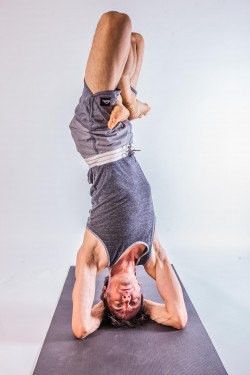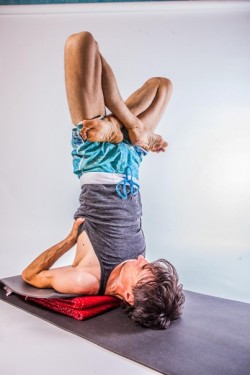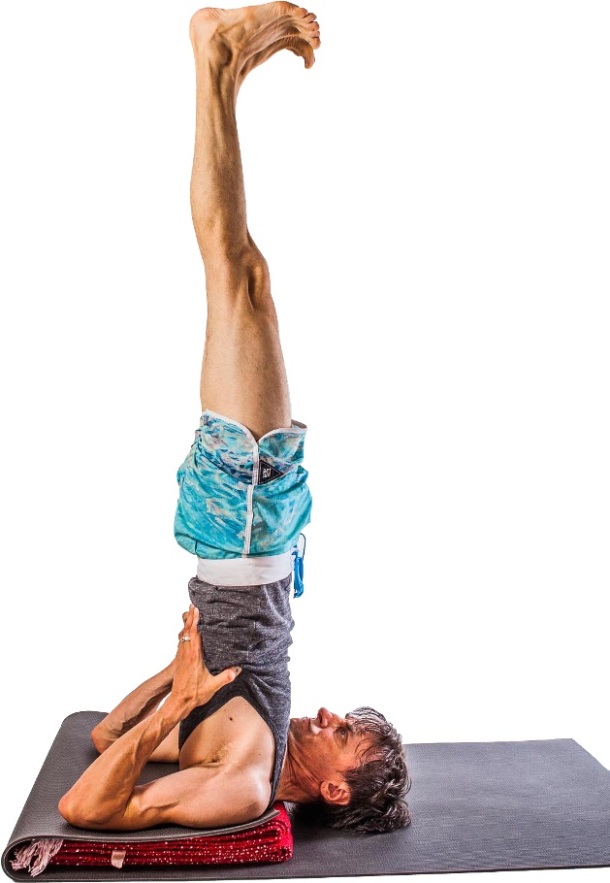I have noticed that people in some yoga circles are “banning” certain yoga poses, namely inversions.
I feel compelled to speak out on behalf of these foundational postures that are central to the practice of hatha yoga. It is challenging not to approach the subject from an emotional standpoint because of how much I love and benefit from doing headstand and shoulderstand, but I will refrain from an outburst and give you my own experience as a student and a teacher of yoga for nearly 25 years.
I take a positive stance on inversions and have concluded they are some of of the best medicine on this planet.
As part of respecting the yogis of the past, I begin from the premise that each asana that you find within hatha yoga texts is there because it helped alleviate suffering and brought some form of healing and joy. Each posture found in the texts or that has continued to be practiced and passed along from teacher to student is there because it adds meditatively, energetically and physically to a hatha yoga practice recipe. From my initial premise that the foundational postures have value, I conduct my own research in my practice.
When I research a posture, I look at it from many angles.
Safety is one study angle. I study the transitions into and out of the posture as well as the act of staying in the posture. I consider the skeletal arrangement along with the function of the muscles and joints, breathing and other factors. I apply a rigorous standard to determine the best way to safely and effectively work at a posture.
What I have found through years of research is that when it comes to the basic, foundational asanas, including inversions, the asana itself is virtually never inherently unsafe. On the contrary, doing the basic postures on a daily basis gives you one of the most potent, preventative, healing modalities available to humanity—doing inversions sits right in the heart of doing the basics. Going upside down is quite simply one of the best, single activities that a person can do to ensure robust health and longevity.

Aadil Palkhiavalia, one of my first, most beloved teachers once said, “without inversions there is no yoga.” In other words, inversions are a major part of what makes hatha yoga a practice of yoga. Aadil made this statement partly because inversions are the postures that form a bridge between the outer limbs (one to five) and the inner limbs (six to eight).
Learning to stay up in headstand is part of what teaches the restless yogi to become still because going upside down gives us an unlikely but super potent entrance into meditation (defined as the ability to create joyful inward states of awareness).
In Sri K Pattabhis Jois’s book, Yoga Mala, on the subject of yoga practice, there are entire pages dedicated to listing the benefits of sirsasana (headstand) and sarvangasana (shoulderstand). These lists of benefits for inversions are significantly longer and more detailed than for any other postures. You will also find a meaningful list of inversion benefits in BKS Iyengar’s Light on Yoga. Additionally ample visual evidence of T Krishnamacharya’s love affair with inversions exists in the form of photos of him doing many playful and well-rehearsed variations in headstand and shoulderstand.

So maybe now you can understand why I am concerned that people are attacking the basic foundational postures. But also, I am aware that the student practicing headstand and the teacher teaching it must know how to do it safely.
I’m agreeing that in the average yoga class, inversions are frequently not being done intelligently, safely or sustainably but we don’t have to conclude that we just stop doing them. To erase the category from the curriculum is not creative thinking and a disrespecting of hatha yoga. The basic postures are all worthy of your efforts to find a creative evolution for doing them. This means adapting, modifying, and approaching the problems and hazards positively.
Here are two questions we can ask ourselves if we are teachers or students of hatha yoga:
As a teacher, if I see a student doing an unsafe inversion, I can immediately take action and ask myself, “How can I make shoulderstand safe for this person so they can still get all the benefits from it?”
If I am a student and I get neck pain from shoulderstand or headstand, I can address the pain and ask myself, “How can I make this posture safe for myself and reap all of the benefits from it?”
Certainly, the decision to do away with headstand and shoulderstand is not supported by the data and evidence that I have collected from my practice and teaching. I recommend that you generate enough interest in these postures to study them and find out what they have to offer. You will find that it is relatively simple to add some basic modifications and props and make them safe for nearly anyone to do.
Author: David Garrigues
Images: Courtesy of Author
Editor: Catherine Monkman









Read 0 comments and reply